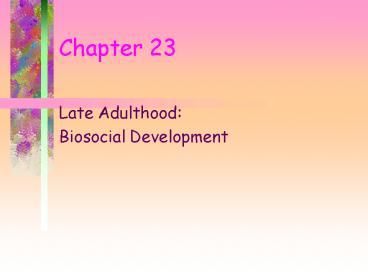Late Adulthood: - PowerPoint PPT Presentation
1 / 24
Title:
Late Adulthood:
Description:
Alteration in overall body height, shape, and weight. With weight loss may come muscle loss ... ability to detect and correct them can lead to harmless ... – PowerPoint PPT presentation
Number of Views:565
Avg rating:3.0/5.0
Title: Late Adulthood:
1
Chapter 23
- Late Adulthood
- Biosocial Development
2
Ageism
- Ageisma term that refers to prejudice against
older people because of their age - Why is ageism so strong?
- cultural emphasis on growth, strength, and
progress - veneration of youth
- increasing age segregation
3
Gerontology
- Gerontologystudy of old age
- GeriatricsThe medical specialty devoted to old
age - Two Different Perspectives
- doctors in geriatrics view aging as an illness
- gerontologists view aging as socially constructed
problem
4
Gerontology, cont.
- Contrary to popular belief, many
developmentalists now view aging, like all other
periods, as marked by gains as well as losses
5
Demography
- A reason ageism is decreasing is that there are
more aging individuals - 7 percent of worlds population now over 65 years
- 13 percent in developed nations such as United
States
6
Demography, cont.
- Changing shape of demographic pyramid
- the population stack has shifted from a pyramid
to a square - reflects changes in recent decadesfewer births
and increased survival - By 2030 the proportion of those over 65 is
projected to double worldwideto 15 percent
7
Dependents and Independence
- Dependency ratioratio of self-sufficient,
productive adults (those between ages 15 and 65)
to dependentschildren and the elderly - the greater the number of dependents compared to
workers, the higher the dependency ratio
8
Dependents and Independence, cont.
- What are some of the problems cultures may face
as baby boomers age? - crisis in geriatric medicine
- Medicare, Social Security, and quality private
health insurance in jeopardy? - entire tax and caregiving burden may fall on
shrinking middle cohort
9
Young, Old, and Oldest
- Distinctions based on age, health, and social
well-being - young-oldhealthy and vigorous, financially
secure, active in family and community life - old-oldhave major physical, mental or social
loses, but still have some strengths - oldest-olddependent on others for almost
everything
10
Young, Old, and Oldest, cont.
- Some gerontologists like the following terms
better - optimal aging
- usual aging
- impaired aging
11
Anti-Aging Measures
- Aging has many causes
- wear and tear
- cellular accidents
- declining immune system
- programmed senescence
12
Calorie Restriction
- Mammals can almost double their life span if they
eat half as much food throughout adulthood - proven for mice and rats probably true for
monkeys, chimps, and dogs - true for humansprobably but must be carefully
done - Pack more nutrients into fewer calories
13
Calorie Restriction, cont.
- Older people take drugs that are considered
harmless, but do affect nutritional requirements - Mammals with reduced calorie intake are stronger,
more vital, and younger in their appearance as
long as they consume adequate vitamins and
minerals
14
The Skin and Hair
- Wrinkles, hair becomes grayer and thinner
15
Body Shape and Muscles
- Alteration in overall body height, shape, and
weight - With weight loss may come muscle loss
- reduces flexibility
- Self-perception can lead to a feeling of
fragility and a fear of falling
16
Dulling of the Senses
- Vision
- Only about 10 percent of elderly see well
- Cataractsshrinking of lens, causing vision to be
cloudy, opaque, and distorted. - Hearing
- Presbycusisage-related hearing loss
- 40 over 65 experience it
- Tinnitisbuzzing or ringing. Experienced by 10
of elderly.
17
Theories of Aging
- Wear and Tear
- The genetic theory
18
Wear and Tear Theory
- Compares body to machine
- Body wears down because of accumulated exposure
to inadequate nutrition, disease, pollution, and
other stresses - Wear out our bodies by living our lives
19
Genetic Aging
- What makes entire body age?
- focus on whole body rather than individual parts
- Some theorists propose that aging is the normal,
natural result of the genetic plan for the species
20
Life Expectancy
- Genetic programming to reach biological
maturation at fixed times and genetically
programmed to die after a fixed number of years - Maximums and Averages
- maximum life span (humans 115)
- average life expectancy
- affected by culture, historical and socioeconomic
factors
21
Cellular Aging
- Cellular Accidents
- accumulation of minor accidents that occur during
cell reproduction cause aging - mutations occur in process of DNA repair
- instructions for creating new cells become
imperfect - cellular imperfections and declining ability to
detect and correct them can lead to harmless
changes, small functional loss, or fatal damage
22
Free Radicals
- Some of bodys metabolic processes can cause
electrons to separate from their atoms and can
result in atoms with unpaired electronoxygen
free radicals - can produce errors in cell maintenance and
repair, leading to cancer, diabetes, etc. - Antioxidantscompounds that nullify the effects
of oxygen free radicals by forming a bond with
their unattached oxygen electron - vitamins A, C, and E, mineral selenium
23
Errors in Duplication
- Hormonal changes triggered in brain that switch
off the genes promoting growth - The Hayflick Limit
- genetic clockaccording to one theory of aging, a
regulatory mechanism in the DNA of cells that
regulates the aging process - cells stop replicating at a certain point
- Evidence for genetic regulation from diseases
producing premature aging
24
The Immune System
- Diminished immune system is weakened
- Two types of attack cells reduced in numbers
- B cells in bone marrow, which create antibodies
that attack invading bacteria and viruses - T cells, which produce substances that attack
infection































